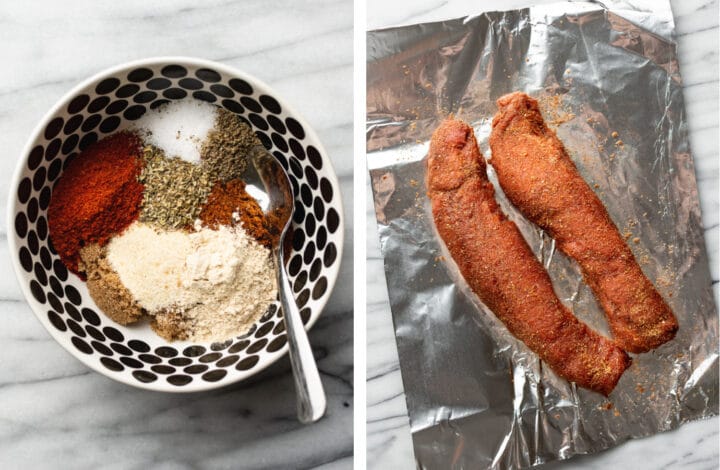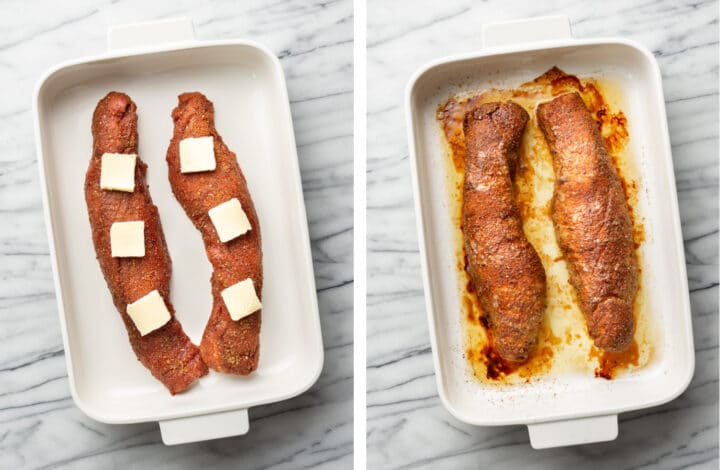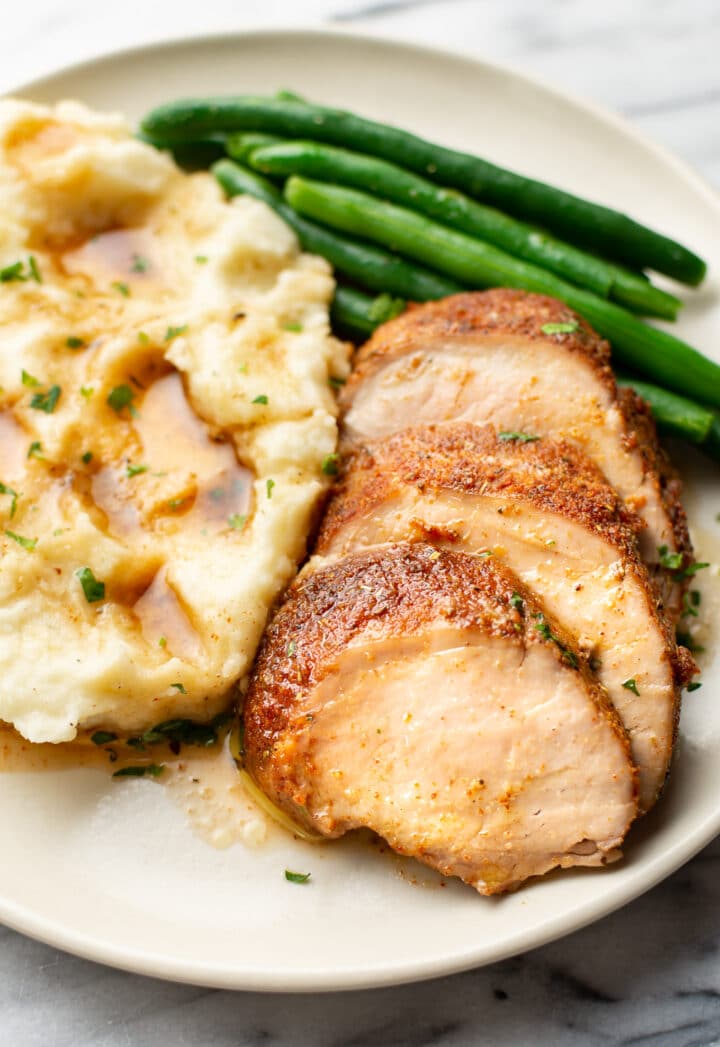This baked pork tenderloin recipe is perfectly juicy and melt-in-your-mouth tender. No searing is required, so it’s fast and has minimal prep! It’s ready in just over 30 minutes.
It’s a lot like my Crockpot Pork Tenderloin, so you might want to give that a try.
Pork tenderloin is a lean, tender cut of meat that can be baked to perfection in the oven without foil. With the right preparation and cooking techniques, you can achieve a juicy, flavorful pork tenderloin with a deliciously crispy, browned exterior. Follow this guide to master oven-roasted pork tenderloin sans foil.
Benefits of Skipping the Foil
Many recipes call for pork tenderloin to be wrapped in foil before oven roasting. However cooking the tenderloin without foil offers some advantages
-
Promotes browning and caramelization on the exterior of the meat for enhanced flavor. The high heat of the oven gives the tenderloin a crispy, browned crust.
-
Allows for even cooking and eliminates concerns about uneven heating that can happen with foil
-
Saves time and effort since you don’t have to wrap and unwrap the foil. Cleanup is easier too without foil.
-
Adds visual appeal with the browned exterior that you don’t get with foil-wrapped meat.
For best results, place the tenderloin directly on a rimmed baking sheet or roasting pan. You can line it with parchment paper for easy cleanup if desired.
Choosing the Right Pork Tenderloin
-
Opt for a 1-1.5 lb pork tenderloin to serve 3-4 people. Larger tenderloins can also be roasted using this method.
-
Choose tenderloins that are evenly sized for even cooking. Avoid oddly shaped or very thick pieces.
-
Make sure the tenderloin is untied if it came tied up. You want it loose for seasoning and even cooking.
-
For maximum browning, select tenderloins with minimal fat since the fat can inhibit caramelization.
Prepare the Meat for Oven Roasting
-
Preheat your oven to 425°F. This high heat helps sear the exterior.
-
Pat the pork tenderloin dry with paper towels to remove excess moisture for better browning.
-
Coat all sides of the tenderloin with olive oil. This helps promote browning and keeps the meat moist.
-
Generously season the pork on all sides with salt, pepper, garlic powder, and other spices or herbs if desired.
-
For extra flavor, marinate the tenderloin in a zip-top bag for 30-60 minutes before cooking.
-
If you have time, let the seasoned tenderloin sit at room temperature for 30 minutes before roasting for more even cooking.
Roast the Tenderloin to Perfection
-
In an oven-safe skillet over medium-high heat, sear the tenderloin on all sides until nicely browned.
-
Transfer the seared tenderloin to a rimmed baking sheet or roasting pan lined with parchment paper.
-
Roast at 425°F, flipping halfway through, until the internal temperature reaches 145°F, about 25 minutes.
-
Smaller tenderloins may take only 20 minutes to reach the target temp. Use a meat thermometer to monitor.
-
After roasting, tent the tenderloin loosely with foil and let rest for 5-10 minutes before slicing.
Serving Suggestions for Oven-Roasted Pork Perfection
The oven-roasted pork tenderloin is incredibly versatile. Slice into medallions to serve in a variety of ways:
-
Serve topped with a flavorful pan sauce made from the fond leftover in the skillet. A maple-Dijon or red wine sauce are classic choices.
-
Pair with roasted vegetables like Brussels sprouts, carrots, or sweet potatoes.
-
For a Mexican twist, top with pico de gallo or pineapple salsa.
-
Make pork tenderloin sandwiches on ciabatta rolls with spinach and provolone.
-
Add to a salad with mixed greens, feta, and balsamic vinaigrette.
-
Stuff into tacos or burrito bowls with all the fixings.
-
Make a hearty grain bowl with quinoa, pork slices, avocado, and chimichurri sauce.
Handy Tips for Oven-Roasted Pork Tenderloin
-
Choose quality pork from a trusted provider for the best results.
-
Let the meat come to room temp before roasting for more even cooking.
-
Use a leave-in meat thermometer to monitor the temp without opening the oven.
-
Add a compound butter under the tenderloin skin before cooking for extra moisture and flavor.
-
If the pork seems to be browning too quickly, tent loosely with foil, leaving it mostly uncovered.
-
Carryover cooking will increase the internal temp 5-10°F after removing from the oven.
-
The roast can be made ahead. Simply slice and reheat gently in the oven or microwave before serving.
Common Questions
What if my pork tenderloin doesn’t brown properly?
-
Make sure the tenderloin is as dry as possible before searing. Blot with paper towels.
-
Use a higher heat skillet and wait until it’s fully heated before adding the pork.
-
Avoid crowding the pan. Cook in batches if needed for proper searing.
What if my pork tenderloin is overcooked and dry?
-
Be sure to use a meat thermometer for accuracy and remove from oven at 145°F.
-
Let the tenderloin rest before slicing to allow juices to redistribute.
-
Add a flavorful sauce, chutney, or salsa on top to provide moisture.
Can I use a roasting rack instead of a baking sheet?
Yes, you can place the tenderloin on a roasting rack set inside a roasting pan. This allows air circulation all around the meat for even browning.
Should I truss my pork tenderloin for oven roasting?
Trussing is not necessary since the tenderloin will cook evenly laid flat in the oven. You want the seasonings to reach all surfaces.
Can I stuff my pork tenderloin before roasting?
Absolutely! Stuffing adds another layer of flavor. Just be sure to monitor the internal temp closely so the stuffing gets heated through properly.
Mastering Oven-Roasted Pork Tenderloin
Cooking pork tenderloin without foil may go against tradition, but the results are worth it. With high heat, thorough seasoning, proper searing, and accurate temperature monitoring, you can achieve a juicy, flavorful pork tenderloin with a crispy exterior crust.
Try this foil-free method for your next special occasion dinner or easy family meal. The simple preparation and incredibly versatile finished roast will have you enjoying oven-roasted pork tenderloin on repeat. Once you master the technique, experiment with different seasonings, marinades, and sauces to put your own spin on this satisfying oven-baked meat.

How to make baked pork tenderloin
This is an overview with step-by-step photos. Full ingredients & instructions are in the recipe card below.

Preheat the oven to 400F. Prep and dry the tenderloins with paper towel. Add the homemade seasoning rub ingredients to a small bowl and mix. Coat the pork with the spice rub uniformly.

Add the seasoned meat to a 9×13 baking dish, and top with the butter. Bake, let it rest to redistribute the juices, and then slice into medallions. Pour the pan juices over, and garnish with chopped fresh parsley.
- Pork tenderloin is very lean, so if you cook it too long, it will dry out. The way farms work has changed, and now pork can be eaten without being overcooked. There’s nothing wrong with a little pink; it means the pork is nice and juicy.
- Because pork tenderloins are usually sold in pairs, this recipe calls for two tenderloins that weigh one pound each. You don’t need to be spot-on with one pound each.
- Use an instant read thermometer with a probe to get the right temperature every time. It’ll beep when it reaches the perfect 145F. This is also great if you have bigger pork tenderloins that take longer than the time suggested in this recipe.
- You should let it rest after it’s cooked but before you cut it. This is when the juices get locked in.
- You can definitely change up the rub. If you want it to be spicy, add some cayenne pepper. There is nothing spicy about it as written. You can change it up however you like, or you can use your favorite jarred variety.
- If you need to, you can use a lot of olive oil instead of the butter.

What to serve with baked pork tenderloin
- Any food that is left over will stay fresh in the fridge for three to four days if it is sealed tightly.
- Warm it back up in a small saucepan over low heat until it’s all gone. Another option is to heat them slowly in the microwave over a low setting. Be careful, though, because the food might dry out when it’s reheated. Definitely use a little additional butter if it needs it.
- Freeze for up to 3 months in individual portions.
